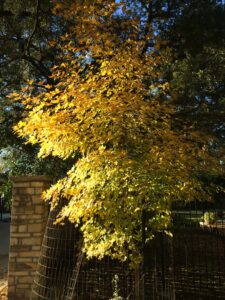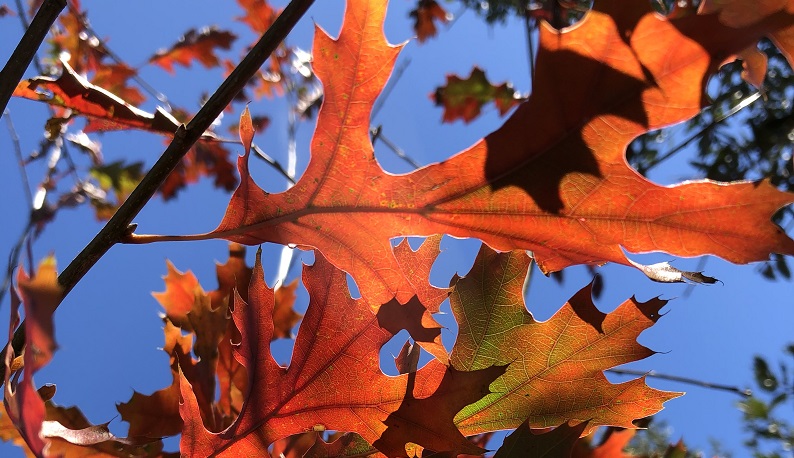What determines if a plant will have good fall color?

Fall color in tree leaves is determined by many factors. Any tree grown from a seed, such as an acorn, will have genetic variability in developing fall color. This is observed by watching our native “Spanish Oaks”, aka Texas Red Oak, as the leaves begin to turn in fall. Many will have beautiful red fall color, but we also observe some trees with leaves that simply turn brown and hang on the tree most of the winter…. (this is called Marcescence)
What if I want to be SURE that a tree that I plant will have fall color? Trees grown from seed, such as Chinese Pistache, Cedar Elm, Big Tooth Maple, Shantung Maple, Shumard Red Oak, Texas Red Oak and Texas Ash can be variable in their ability to form fall color.
The only way to be certain a tree has the potential to have fall color is to BUY IT IN THE FALL WHEN IT HAS FALL COLOR!

If a tree is “grafted”, such as the Bradford Pear and some varieties of Japanese Maples, the genetics will be identical on all of them, as they all come from one common ancestor. Crape Myrtle varieties which are propagated from cuttings will also be genetically identical. This means that when conditions are optimum for fall color to appear, these trees will be very likely to have the expected fall color.
What causes the leaves to change color?

Color changes are the result of transformations in leaf pigment. The green pigment in leaves is the chlorophyll, which absorbs red and blue light from sunlight. The light reflected from the leaf is diminished in red and blue and the leaf appears green. Chlorophyll is not a very stable compound, and degrades in low temperatures and bright sunshine. This is what begins the process of fall color changes in trees. For the other colors in the leaf to show up, the chlorophyll must go away.
Carotene is a compound found in many leaves. It absorbs blue-green and blue light, and the light reflected from carotene appears yellow.
Anthocyanin absorbs blue, blue-green and green light. Therefore the light reflected from leaves containing anthocyanin appear red.

Shortening days and cooling nights of autumn trigger other changes in the tree. An abscission layer forms between the leaf stem and the branch, interrupting the nutrient flow and the production of chlorophyll. If the leaf contains Carotene, the leaf will change from green to bright yellow as the chlorophyll disappears. In some trees, the concentration of sugar in the leaf increases, which reacts to form Anthocyanins. These pigments cause the leaf to turn red if the sap is acidic or purple if the sap is less acidic.
What are the “optimum” conditions for fall color to appear?
The range and intensity of fall color is greatly influenced by the weather. Low temperatures destroy chlorophyll, and if temperatures stay above freezing, it will promote the formation of anthocyanin. Bright sunshine also destroys chlorophyll and enhances anthocyanin production. Dry weather, by increasing sugar content in sap, also increases the amount of anthocyanin. So the brightest autumn colors will be produced when dry, sunny days are followed by cool, dry nights!
Summer drought and high temperatures in the fall will mute fall color. Some trees have brown leaves from drought and will not turn in the fall. With two summers of record heat and drought behind us, the best you can do for your trees is to be sure they are watered beneath the canopy every 3-4 weeks in the winter if we do not receive one inch of rain. Then we will see about next year!
What is Marcescence?
Have you ever noticed a tree that retains its brown leaves in the winter? This is a phenomenon called “Marcescence”. It occurs when the abscission layer that usually forms at the base of the leaf petiole does not separate and allow the leaf to fall. In these trees, the abscission layer is not activated until spring. What causes this phenomenon? No one knows. It is specific to certain species of trees, such as Beech and some species of Oaks. Like many things in nature, it is a mystery.
